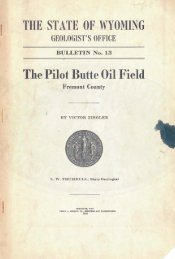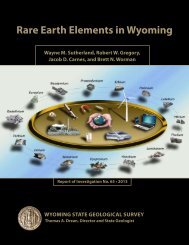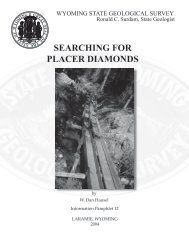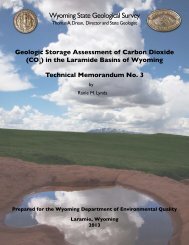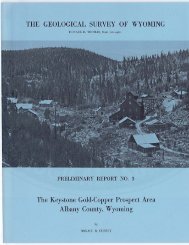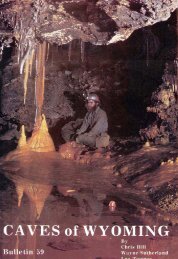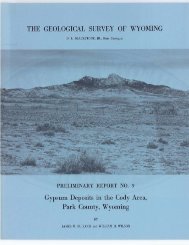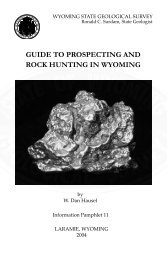The Dinosaurs of Wyoming - Wyoming State Geological Survey ...
The Dinosaurs of Wyoming - Wyoming State Geological Survey ...
The Dinosaurs of Wyoming - Wyoming State Geological Survey ...
You also want an ePaper? Increase the reach of your titles
YUMPU automatically turns print PDFs into web optimized ePapers that Google loves.
PREFACE<br />
<strong>The</strong> subject <strong>of</strong> dinosaurs in general, and the dinosaurs <strong>of</strong><br />
<strong>Wyoming</strong> in particular, has interested me since the spring <strong>of</strong><br />
1904, when for the first time I dropped <strong>of</strong>f the train at Rawlins<br />
for a summer's work in the fossil beds <strong>of</strong> the Wind River<br />
Mountain area. I found the party waiting, ready to start in<br />
a light wagon equipped with the bows for a canvas cover-a<br />
common sight. We soon started on our drive to Lander, one<br />
hundred and fifty miles away-a full week's journey in those<br />
days. After that summer I spent several more seasons in the<br />
<strong>Wyoming</strong> fossil fields, either vvith Dr. S. \V. Williston as companion<br />
or working under his directions.<br />
In the many camps we had together Dr. Williston told me<br />
<strong>of</strong> his work at Como Bluffs, excavating dinosaur bones for<br />
Pr<strong>of</strong>essor Marsh; a terribly lonely job during the early winter<br />
months <strong>of</strong> the late seventies. As an amateur dipterologist<br />
I had in my bag the second edition <strong>of</strong> vVilliston's Manual <strong>of</strong><br />
Jorth American Diptera. I shall never forget the keen<br />
pleasure derived from hearing the author tell how in his despair<br />
at not being allowed to write about dinosaurs, a form <strong>of</strong><br />
activity which Pr<strong>of</strong>essor Marsh reserved for himself, he had<br />
turned to the study <strong>of</strong> the Diptera, a study at which he became<br />
famous. But ever mingled in with other talk there was<br />
always that background <strong>of</strong> the huge, ungainly dinosaurian<br />
. reptiles, making a unique appeal to our fancy. What were the<br />
dinosaurs? Where had they come from? Why had so many<br />
lived and left their bones in the area now called \iVyoming?<br />
What was their manner <strong>of</strong> life? To what reptilian group were<br />
they related?<br />
During the three years I spent in Williston's laboratory as<br />
Fellow in Vertebrate Paleontology at the University <strong>of</strong><br />
Chicago, our discussions <strong>of</strong> dinosaurian affairs were <strong>of</strong> the<br />
greatest interest. In one <strong>of</strong> our daily searches for marine reptiles<br />
in <strong>Wyoming</strong>, especially the plesiosaurs, we one day came<br />
across a tangled lot <strong>of</strong> fossil bones, so broken and water worn<br />
that we couldn't tell what great group <strong>of</strong> vertebrates the fragments<br />
represented. 'vVe thought it might be a giant turtle.<br />
One interesting looking chunk was taken to camp, where in<br />
a red-water irrigation ditch Dr. \Villiston scrubbed <strong>of</strong>f the<br />
crust <strong>of</strong> mud in which the specimen was caked. After he had<br />
cleaned it somewhat I heard him say: "By George, Moodie,<br />
"i




